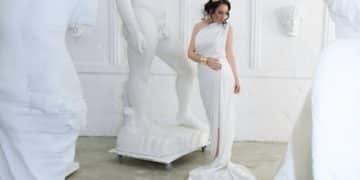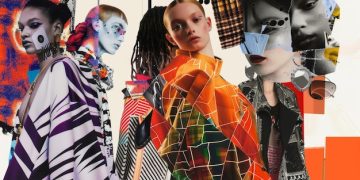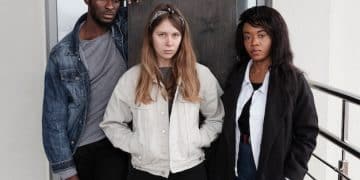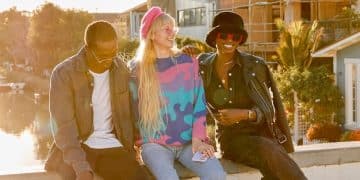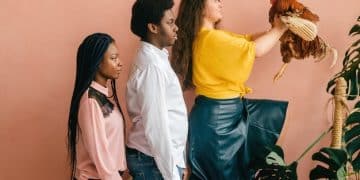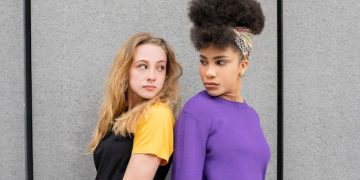Underground Fashion’s Art World Collision: Where Trends Meet Canvas
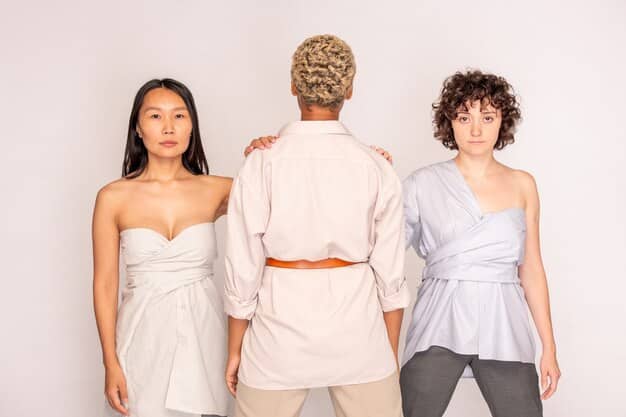
Underground fashion’s art world crossover signifies a dynamic intersection where unconventional styles and artistic expressions merge, challenging traditional fashion norms and fostering a unique form of creative collaboration.
The dynamic world of underground fashion’s art world crossover represents a thrilling rebellion against mainstream norms, where clothing becomes a canvas and runways transform into galleries. This fusion sparks innovative trends and celebrates individual expression in its rawest form.
Unveiling the Underground Fashion Scene
The underground fashion scene is constantly evolving, driven by creativity and a desire to stand out. It’s a space where individuals express themselves through unique styles and challenge conventional norms. This rebellious spirit often finds a natural ally in the art world.
Whether it’s through custom-designed clothing or collaborative projects with artists, underground fashionistas are pushing the boundaries of what’s considered fashionable. Exploring this vibrant landscape requires an appreciation for individuality and a willingness to embrace the unconventional.
Defining Underground Fashion Subcultures
Underground fashion isn’t a monolithic entity. It encompasses a variety of subcultures, each with its unique aesthetic and philosophy. From punk to goth to streetwear, these movements offer distinct expressions of personal identity.
The DIY Ethos
A core element of underground fashion is the do-it-yourself (DIY) ethos. Individuals create their own clothing, modify existing pieces, and experiment with unique materials. This hands-on approach fosters a sense of ownership and allows for truly personalized style.
- Punk: Known for its rebellious spirit, ripped clothing, and safety pin embellishments.
- Goth: Characterized by dark colors, Victorian influences, and a fascination with the macabre.
- Streetwear: Inspired by hip-hop and skate culture, featuring oversized clothing, bold graphics, and athletic wear.
- Cyberpunk: A futuristic aesthetic blending dystopian elements with tech-inspired designs.
In summary, the underground fashion scene thrives on creativity and self-expression. It encompasses various subcultures and empowers individuals to challenge conventional norms through DIY fashion and unique styles.
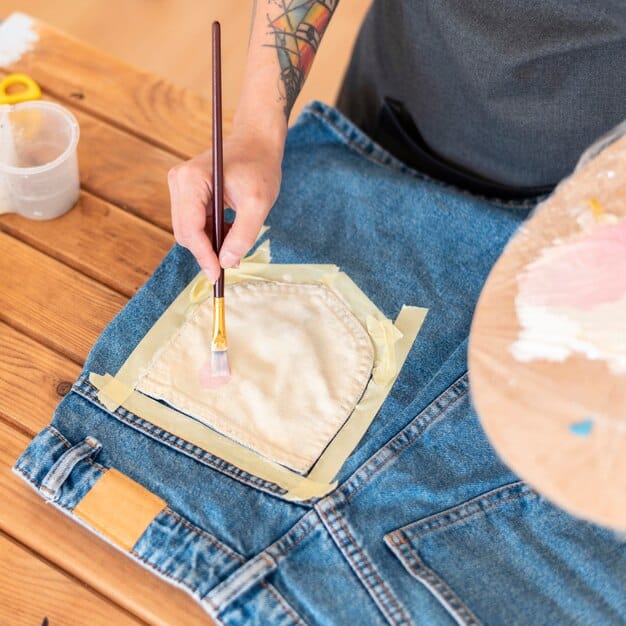
The Art World’s Embrace of Fashion
The art world has increasingly embraced fashion as a legitimate form of artistic expression. This embrace blurs the lines between wearable art and traditional art forms like painting and sculpture. Many artists now use clothing and accessories as canvases to convey powerful messages or explore complex themes.
Museum exhibitions dedicated to fashion designers and collaborations between artists and fashion brands have become commonplace. This recognition highlights the cultural significance of fashion and its potential as a medium for artistic experimentation.
Fashion as a Medium for Artistic Expression
Fashion provides artists with a unique opportunity to engage with the human body and explore themes of identity, culture, and social commentary. Artists can use clothing to create transformative experiences for both the wearer and the viewer.
Collaborations Between Artists and Fashion Brands
Collaborations between artists and fashion brands often result in innovative and thought-provoking designs. These partnerships allow artists to reach a wider audience and bring their artistic vision to the world of fashion.
- Wearable Art: Innovative garments that blend artistic expression with functionality.
- Fashion Installations: Art installations that showcase clothing and accessories in unconventional ways.
- Artist-Designed Collections: Fashion collections created in collaboration with visual artists.
In conclusion, the art world’s embrace of fashion has blurred the lines between wearable art and traditional art forms. Through collaborations and innovative designs, fashion has become a powerful medium for artistic expression.
Key Figures in the Crossover
The intersection of underground fashion and art has been shaped by several key figures who challenge traditional boundaries. These visionary designers and artists have pioneered new forms of creative expression, creating a lasting impact on both industries.
Discovering these innovators requires exploring their unique perspectives. Their work inspires others to embrace individuality, leading to groundbreaking collaborations and fashion statements in the modern art world.
Pioneering Designers: Challenging Fashion Norms
A number of designers have consistently pushed the boundaries of fashion, incorporating artistic elements into their creations. They often draw inspiration from various art forms and challenge conventional notions of beauty and style.
Artists Who Dare to Wear: Blurring Disciplinary Lines
Some visual artists have ventured into the world of fashion, using clothing as a canvas for their artistic visions. They create wearable art pieces that reflect their unique perspectives and challenge disciplinary boundaries.
- Alexander McQueen: Known for his dramatic runway shows and avant-garde designs.
- Vivienne Westwood: A punk icon who transformed fashion into a platform for political expression.
- Yayoi Kusama: A visual artist whose polka-dot patterns have been incorporated into fashion collections.
- Takashi Murakami: A contemporary artist whose colorful and whimsical designs have been featured in fashion collaborations.
Essentially, visionary designers and artists shape the merger of underground fashion and art, pioneering creative expressions that inspire others to challenge traditional norms and explore unique styles. Their impact is seen in innovative approaches to wearable art and collaborative projects.
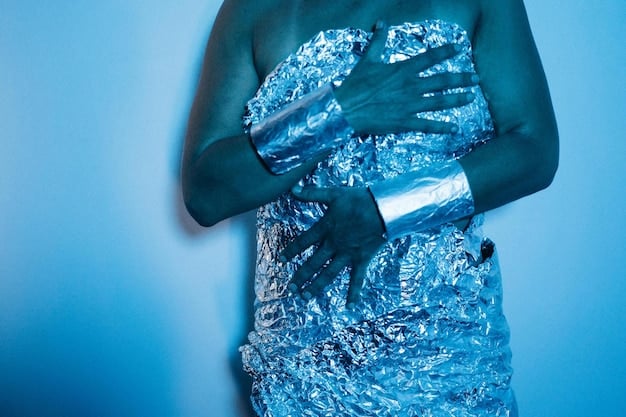
The Impact of Street Art and Graffiti
Street art and graffiti have had a huge influence on underground fashion, bringing raw, urban aesthetics to clothing designs. Artists transfer their work from city walls to wearable art, creating a dynamic merging of street culture and high fashion.
By examining this cultural transformation, we recognize the ability of street art to encourage creativity, challenge conventions, and convey social messages. This leads to the production of cutting-edge streetwear and artistic collaborations.
From Walls to Wardrobes: Street Art’s Evolution
Street art has evolved from being a marginalized form of expression to becoming a recognized art form. Its influence on fashion can be seen in the appropriation of graffiti techniques, bold graphics, and unconventional materials.
Wearable Canvases: Graffiti-Inspired Fashion
Designers are increasingly incorporating graffiti-inspired elements into their collections, creating wearable canvases that reflect the energy and vibrancy of urban landscapes. These designs often feature bold colors, intricate patterns, and social commentary.
- Graffiti Prints: Clothing featuring prints inspired by graffiti art and street murals.
- Customized Pieces: Hand-painted clothing and accessories with unique graffiti designs.
- Collaborations: Partnerships between graffiti artists and fashion brands to create limited-edition collections.
To summarize, Street art and graffiti strongly influence underground fashion, introducing dynamic aesthetics to clothing designs. Street artists encourage creativity by challenging conventions and producing cutting-edge streetwear, revolutionizing the industry.
Sustainability and Ethical Practices
As consumers become more aware of the environmental and social impact of their fashion choices, sustainability and ethical practices have become central to underground fashion. Designers are exploring innovative ways to create clothing and accessories that minimize waste, reduce pollution, and support fair labor practices.
By adopting ethical and sustainable practices, underground fashion represents ecological awareness, offering innovative methods to minimize fashion waste and enhance environmental protection, catering to more consumers.
Upcycling and Repurposing: Giving New Life to Old Materials
Upcycling and repurposing are key strategies for promoting sustainability in underground fashion. Designers transform discarded materials into unique and stylish garments, reducing waste and creating one-of-a-kind pieces.
Ethical Production: Supporting Fair Labor Practices
Ethical production practices ensure that garment workers are treated fairly and paid a living wage. Underground fashion brands are increasingly committed to transparency and accountability in their supply chains.
- Sustainable Materials: Using organic cotton, recycled fabrics, and other eco-friendly materials.
- Zero-Waste Design: Creating garments that minimize fabric waste during the production process.
- Transparency: Providing consumers with information about the origin and production of their clothing.
Moreover, Sustainability and ethical practices play a central role, with designers exploring methods to minimize waste and promote ethical labor. The movement mirrors an increase in ecological awareness, enhancing environmental solutions.
The Influence of Music and Pop Culture
Music and pop culture heavily influence underground fashion, establishing themes and encouraging individuality. Artists and cultural movements frequently influence how individuals express themselves through clothing choices, blending musical aesthetics with fashion trends.
By considering fashion’s function in cultural identity, we can appreciate how music and pop culture establish unique aesthetics. These themes and connections demonstrate the dynamic merger of music, culture, and self-expression in unique fashion scenes.
Musical Aesthetics: From Punk to Hip-Hop
Different music genres have spawned unique fashion aesthetics. Punk, goth, hip-hop, and electronic music have all influenced clothing styles and self-expression.
Celebrity Influence: Fashion Icons and Trendsetters
Celebrities often set trends and inspire fashion movements. Their clothing choices and personal styles become symbols of cultural identity and artistic expression.
- Punk Rock: Distressed clothing, band t-shirts, and DIY embellishments.
- Hip-Hop: Oversized clothing, sneakers, and streetwear-inspired designs.
- Electronic Music: Futuristic designs, geometric patterns, and neon colors.
To conclude, Music and pop culture significantly influence underground fashion, creating distinct aesthetics and promoting self-expression. Artists and cultural groups affect how clothing choices demonstrate an individual’s identity, creating a fusion of musical tones and current fashion trends.
| Key Point | Brief Description |
|---|---|
| 🎨 Art Influence | Art enhances fashion, using clothes as canvases. |
| 🎸 Music’s Role | Music shapes fashion styles from punk to hip-hop. |
| ♻️ Sustainability | Eco-friendly methods such as upcycling drive fashion. |
| 🏙️ Street Art | Urban art influences bold, wearable designs. |
FAQ
▼
Underground fashion is fashion that goes against common style norms and emerges from subcultures, promoting uniqueness. It is often characterized by DIY aesthetics, bold statements, and rejection of mainstream trends.
▼
Art enriches fashion by providing clothes with canvas-like qualities. Designers and artists blend their talents to produce wearable artworks with artistic creations. This combination results in avant-garde designs that speak to societal themes.
▼
Concern for environmental effect drives underground fashion. Designers make ethical decisions to decrease waste and advance moral labor standards through recycling materials and supporting honest manufacturing practices.
▼
Music genres such as punk and hip-hop significantly influence underground fashion trends by establishing certain visual themes. Musicians frequently influence the fashion decisions of their devotees, promoting the blending of musical aesthetics into style.
▼
Street art infuses creativity into fashion with its edgy, urban appearance. Graffiti, strong graphics, and unusual materials converted into wearable paintings give clothing designs new life while also mirroring a city’s vibrant energy.
Conclusion
The symbiotic relationship between underground fashion and art illuminates how innovation, sustainability, and cultural influences integrate into expressing unique perspectives. By embracing these dynamic forces, both designers and consumers can explore self-expression and challenge conventions which leads to more creative and meaningful fashion.
